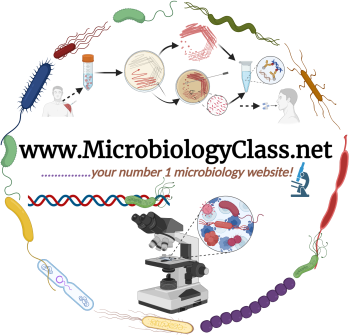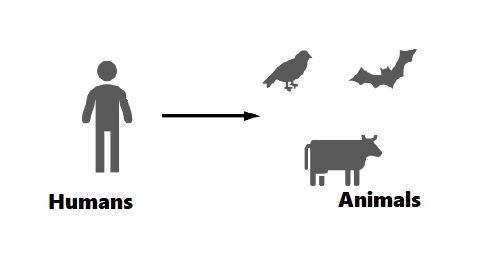An anthroponotic disease, or anthroponosis, is an infectious disease in which a disease causing agent carried by humans is transferred to other animals. It may cause the same disease or a different disease in other animals. The opposite of anthroponosis or anthroponotic disease is zoonosis. Zoonosis is a disease transmitted from animals to humans.
Zoonoses (also known as zoonosis and as zoonotic diseases) are infectious diseases caused by bacteria, viruses and parasites that spread between animals (usually vertebrates) and humans. Major modern diseases such as Ebola virus disease and salmonellosis are zoonoses.
Human communicable diseases can be classified according to the source of infection as anthroponoses (when the source is an infectious human; interhuman transfer is typical), zoonoses (the source is an infectious animal; interhuman transfer is uncommon), and sapronoses (the source is an abiotic substrate, nonliving environment; interhuman transfer is exceptional). The source of infection is often the reservoir or, in ecologic terms, the habitat where the etiologic agent of the disease normally thrives, grows, and replicates.
A characteristic feature of most zoonoses and sapronoses is that once transmitted to humans, the epidemic chain is usually aborted, but the clinical course might be sometimes quite severe, even fatal. An ecologic rule specifies that an obligatory parasite should not kill its host to benefit from the adapted long-term symbiosis, whereas an occasionally attacked alien host, such as a human, might be subjected to a severe disease or even killed rapidly by the parasite because no evolutionary adaptation to that host exists.
Anthroponoses (Greek “anthrópos” = man, “nosos” = disease) are diseases transmissible from human to human. Examples include rubella, smallpox, diphtheria, gonorrhea, ringworm (Trichophyton rubrum), and trichomoniasis.
Zoonoses (Greek “zoon” = animal) are diseases transmissible from living animals to humans. These diseases were formerly called anthropozoonoses, and the diseases transmissible from humans to animals were called zooanthroponoses.
Zoonotic diseases can be classified according to the ecosystem in which they circulate. The classification is either synanthropic zoonoses, with an urban (domestic) cycle in which the source of infection are domestic and synanthropic animals (e.g., urban rabies, cat scratch disease, and zoonotic ringworm) or exoanthropic zoonoses, with a sylvatic (feral and wild) cycle in natural foci outside human habitats (e.g., arboviroses, wildlife rabies, Lyme disease, and tularemia).
However, some zoonoses can circulate in both urban and natural cycles (e.g., yellow fever and Chagas disease). A number of zoonotic agents are arthropod-borne; others are transmitted by direct contact, alimentary (foodborne and waterborne), or aerogenic (airborne) routes; and some are rodent-borne.
Sapronoses (Greek “sapros” = decaying; “sapron” means in ecology a decaying organic substrate) are human diseases transmissible from abiotic environment (soil, water, decaying plants, or animal corpses, excreta, and other substrata). The ability of the agent to grow saprophytically and replicate in these substrata (i.e., not only to survive or contaminate them secondarily) are the most important characteristics of a sapronotic microbe. Sapronotic agents thus carry on two diverse ways of life: saprophytic (in an abiotic substrate at ambient temperature) and parasitic (pathogenic, at the temperature of a homeotherm vertebrate host).
Typical sapronoses are visceral mycoses caused by dimorphic fungi (e.g., coccidioidomycosis and histoplasmosis), “monomorphic” fungi (e.g., aspergillosis and cryptococcosis), certain superficial mycoses (Microsporum gypseum), some bacterial diseases (e.g., legionellosis), and protozoan (e.g., primary amebic meningoencephalitis). Intracellular parasites of animals (viruses, rickettsiae, and chlamydiae) cannot be sapronotic agents. The term “sapronosis” was introduced in epidemiology as a useful concept.
Anthroponosis refers to an infectious disease of humans that can be transmitted naturally to other animals. It is a reverse of the zoonosis wherein a pathogen or a parasite infects primarily an animal but can also infect and cause disease (usually with more symptoms) in humans.
The disease transferred by a human host to an animal host may cause the same disease or a different disease in the animal host. Examples of an anthroponosis are leishmaniasis and tuberculosis, although both of them may also serve as a zoonotic disease.
The mode of transmission of anthroponotic diseases is usually through skin contact. Primates are also usually the type of animals that become prone to acquiring infectious diseases of humans. That is because humans and other primates due to their extensive biological similarities. Primates in enclosures such as zoos and research facilities are usually at risk to anthroponosis. One of the preventive measures of transmitting diseases between humans and these animals is by administering vaccines to them that are similarly given to humans.
References
- Lederberg J. Infectious disease as an evolutionary paradigm. Emerg Infect Dis. 1997;3:417–23.
- Bell JC, Palmer SR, Payne JM. The zoonoses (infections transmitted from animals to man). London: Arnold; 1988.
- World Health Organization. Joint WHO/FAO expert committee on zoonoses. 2nd report. WHO technical report series no. 169, Geneva; 1959. 3rd report, WHO Technical Report Series no. 378, Geneva; The Organization; 1967.
- Pavlovsky EN. Natural nidality of transmissible diseases. Urbana (IL): University of Illinois Press; 1966.
- Beaty BJ, Marquardt WC, eds. The biology of disease vectors. Niwot (CO): University Press of Colorado; 1996.
- Terskikh VI. Diseases of humans and animals caused by microbes able to reproduce in an abiotic environment that represents their living habitat [in Russian]. Zhurn Mikrobiol Epidemiol Immunobiol (Moscow). 1958;8:118–22.
- Somov GP, Litvin VJ. Saprophytism and parasitism of pathogenic bacteria—ecological aspects (in Russian). Novosibirsk: Nauka; 1988.
- Krauss H, Weber A, Enders B, Schiefer HG, Slenczka W, Zahner H. Zoonosen, 2. Aufl. Köln: Deutscher Ärzte-Verlag; 1997.
- Schwabe CV. Veterinary medicine and human health. Baltimore: Williams & Wilkins; 1964.
Discover more from Microbiology Class
Subscribe to get the latest posts sent to your email.





